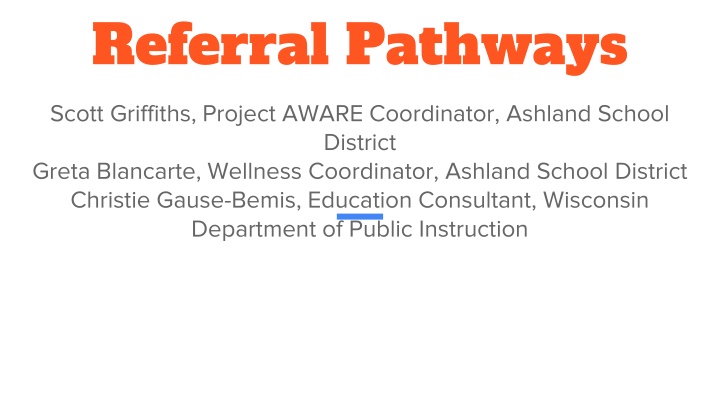
Enhancing Mental Health Support: Referral Pathways in School Districts
Explore the development and implementation of referral pathways for students facing mental health challenges in school districts. Discover key components, case studies, and strategies to increase access to mental health support services.
Download Presentation

Please find below an Image/Link to download the presentation.
The content on the website is provided AS IS for your information and personal use only. It may not be sold, licensed, or shared on other websites without obtaining consent from the author. If you encounter any issues during the download, it is possible that the publisher has removed the file from their server.
You are allowed to download the files provided on this website for personal or commercial use, subject to the condition that they are used lawfully. All files are the property of their respective owners.
The content on the website is provided AS IS for your information and personal use only. It may not be sold, licensed, or shared on other websites without obtaining consent from the author.
E N D
Presentation Transcript
Referral Pathways Scott Griffiths, Project AWARE Coordinator, Ashland School District Greta Blancarte, Wellness Coordinator, Ashland School District Christie Gause-Bemis, Education Consultant, Wisconsin Department of Public Instruction
Objectives Learn about the components of Referral Pathways for students with mental health challenges Develop tools to take back to your district to design a referral pathway See referral pathways in practice in communities whom have developed methods of increasing access to supports for youth with mental health challenges
Key Components to Referral Pathways Internal Referral Flowchart External Referral Flowchart Screening tools and Criteria Resource Mapping: Internal and External Warm Hand-off Family and Community Engagement Consent, Confidentiality, and Monitoring Progress
School District of Ashland: 1 Year Ago There was no consistent referral pathway system Family follow through had been a primary obstacle Providers were: Willing to provide services in school Mostly at capacity Willing to scale up by adding additional providers Providers needed: More appropriate space Consistent point of contact
Referrals Flowchart Examples: Ashland School District, Racine Unified School District, Menominee Indian School District
Referrals by administration, teachers, staff, concerned members of community, peers, parents, self Follow up Identification Did referral to services happen? Monitor need Groups based on needs, educational needs, training, academics, social emotional, intensity matches level of need Written referral info, observation, academic, attendance, discipline, screenings Background Review Support School-Based Community based Free, low-cost, private Interview/Student and Family Contact Referral for services
Resource Mapping To ensure all staff is aware of school and community resources To systematize referral process To identify school and community assets and state and national supports To identify gaps in needed resources To share with families what is available
Ashland Referral Pathway https://www.lucidchart.com/documents/view/abe788ac-41ca-4981-8383-138ea37a67ac
Warm Hand-off Establishes a bridge of trust between student and new provider Creates a means of information sharing agreements that includes youth and family voice Increases the success of referral (barriers have been identified and dealt with) Provides a chance to clarify roles and responsibilities to support the youth
Consents to Treatment Voluntary treatment is preferred Engages Family Establishes patient rights Agreements around information sharing are established
Confidentiality Establishing who needs to know what Engaging with families and community supports Handle with Care program HIPPA and FERPA compliance Maintaining the therapeutic relationship Ensuring the therapist has the necessary data from the school and vice versa
Monitoring Progress Is treatment working? Is the level of treatment aligned with the level of need of the youth? If treatment is not progressing, or misaligned, what is the alternative? Ensuring the right fit for youth and therapeutic relationship Monitors if appointments have been maintained Identifies barriers to treatment and solutions
Behavioral Health Coordinator/Social Worker Support families to navigate system: Insurance, providers and external resources Warm Hand-off Support providers with consistent point of contact and coordination (spaces, MOUs, Information Sharing) Assessments and provider/service matches can t be done by a computer Existing staff at capacity for providing services Job Description: https://docs.google.com/document/d/1JQUZsNGtsNvYd- mXfnwUDE5D1nEYsKYfEs2GFVikvq4/edit
